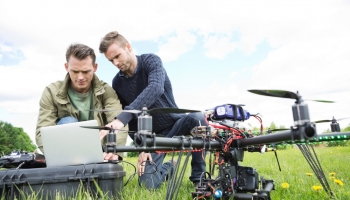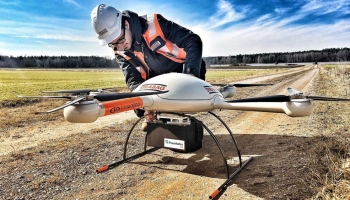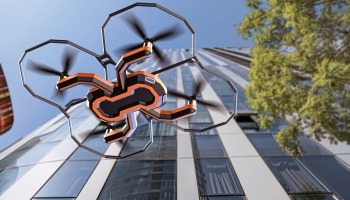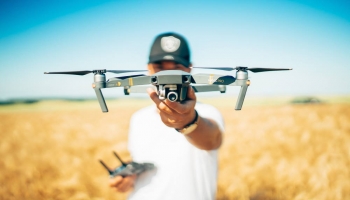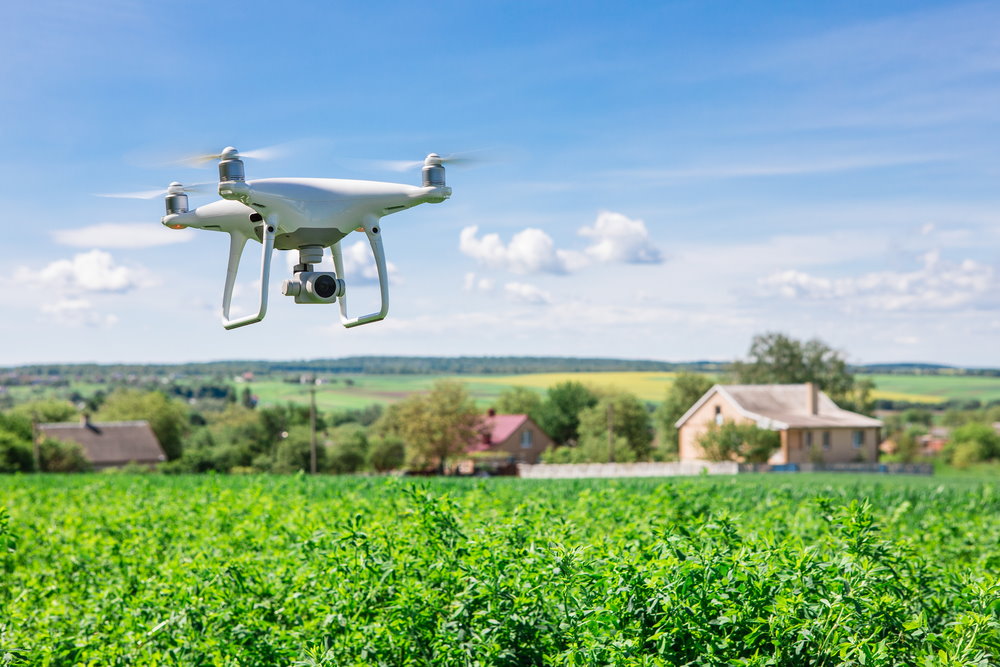
What are drones useful for?
An examination of the fields that have not adopted drone technology may very well be the shorter list of the two.
Drones can be used in a virtually limitless capacity, ranging from making a simple day at the park far more exciting, to navigating the heretofore uncharted territory of the planet Mars.
Drones have demonstrated their usefulness in military settings, commercial settings, and more, and may even be making their way into educational curriculums and technology classrooms around the globe.
Before we dive too deeply into the many uses of drones, however, let’s take a quick look at the basic components that make up drone technology.
What Are Drones, Exactly?
Drones are a specific type of aircraft that have been used for the past fifty years to eliminate the risks associated with soldiers going to war, and carrying out corresponding missions.
Drones are, technically, any unmanned aircraft, though “unmanned” may be something of a misnomer.
Rather than being entirely unmanned, drones are remotely manned.
This particular type of aircraft is controlled via one of two measures: remote control or control following a specific set of prescribed programs, typically using GPS and computer programming as basic guides.
Available Drone Types
To successfully accomplish the many potential uses of drones, you must select the drone that is best suited to your purposes.
There are four basic types of drones currently available to the public, each of which is able to fulfill a different function.
These four types include the following:
- Single-rotor drones
- Multi-rotor drones
- Fixed-wing drones
- Fixed-wing hybrid drones.
Single-rotor drones are most commonly compared to the structure and function of helicopters, as they are heavy-duty, complex, and capable of carrying large loads, though they are among the most expensive drone models available, and require a great deal of maintenance and care to safely and effectively use.
Multi-rotor drones are among the most common drones currently in use for commercial and personal use, as they are lightweight and easy to use. They can be used for a variety of tasks, including taking images or videos from a significant height, and over shorter distances. These drones are also typically the least expensive drones available, and are a great starting point for anyone who has never used a drone before.
Fixed-wing drones are those that are most commonly associated with military use, and most closely resemble a slightly compressed, much smaller airplane. Fixed-wing drones can also be used in home or commercial applications, and many people prefer the sleek design and dramatically increased usability of this particular drone style.
Fixed-wing hybrids are drone hybrids that combine the stability of fixed-wing drones with the portability, weight, and efficacy of multi-rotor drones. They are not as widely distributed as the other types of drones, and are still largely in their infancy, but they are a great option for someone who is looking for the best of both worlds.
How Drones Can Be Used
The original focus of drones was military involvement, but the potential uses of drones have long since expanded to include commercial and private uses.
Drones can be utilized in a host of avenues, including customer service, delivery, inspection services, surveying, and far more, and are poised to become powerful helpers in most major industries.
What exactly are drones capable of?
To illustrate the seemingly limitless application of drone technology, we’ll look at the most common industries currently utilizing and further developing drone technology.
Disaster Relief Efforts
Disaster relief efforts are frequently burdened by lack of resources and lack of funds, in addition to the high risks involved in going in for disaster relief.
From disease and debris to unsafe air, natural disasters can wreak havoc on a geographic area and render spaces virtually unlivable.
Drones can help mitigate some of these issues, by delivering necessary medication, surveying the area, and mapping out potential escape or safety routes for people who are on the ground and actively engaging in relief activities.
Drones can be a powerful tool in disaster relief efforts of all types, as they can safely evaluate areas in need of help, and can even assess the stability of a building before sending rescue teams in.
Military Operations
Drones actually began as a technology specifically developed for the military, and drones have long been used as a way to gather reconnaissance, monitor activity in areas of concern, and even conduct air strikes without direct soldier involvement.
Militaries have been circling drone production for over 100 years, and today, most major military outfits possess at least dozens of drones, if not hundreds, that carry out simple tasks, such as routine inspection and more complex tasks, such as conducting air strikes.
Conservation Efforts
Conservation efforts have also been helped along with the use of drones, as drones are able to visit remote locations with minimal disturbance to local wildlife, and can gather photos, scans, and other information about an area with minimal invasion.
This is an enormously valuable tool, as conservation is often hampered by the issue of harming areas in need of preservation, and drones can be used to bridge a gap between conservation and human involvement.
Drones can also be used to measure increasing or declining populations of animals that are endangered or threatened, without having to put up a permanent surveillance system.
Healthcare and Disease
The most significant way that drones have impacted healthcare and disease is through delivery availability.
Many rural areas and third-world countries do not have regular access to healing medicine, such as vaccines.
Drones have been used to rectify the issue of distance with regard to medical supplies, and show immense promise as a sustainable and effective way to deliver much-needed healthcare supplies to remote, underserved areas.
By administering medicine early on (including preventative technology, such as vaccines), drones are actively preventing disease.
Farming and Agriculture
Drones offer far more manpower in farming than farmhands alone are capable of, and have seen a dramatic surge in use among farmers large and small.
Drones can be used to map existing farmland, evaluate crop yield, evenly distribute pesticides and herbicides, and even monitor livestock.
Drones allow farmers to improve efficiency and potentially improve crop yield.
Weather Forecasting
Drones have become increasingly important in both weather forecasting and journalism, as both benefit from the sleek, quick nature of drones, and the ability of drones to move into areas that humans might struggle to inhabit or evaluate.
Drones have been used to forecast the weather by being released into the air while being outfitted with sensors.
These sensors are able to capture weather readings in real time, and report those readings back to meteorologists.
When used in conjunction with existing weather reporting models, drones can be enormously helpful in expanding our understanding of and prediction models for weather in different regions.
Journalism
Journalism has a similarly important investment in drone usage, as drones are able to move into tight spaces and potentially hazardous situations to capture footage that might put a journalist in danger.
From hazardous explosions and illegal activities to hazardous weather situations and natural disasters, drones have allowed journalists to increase their reach and improve their ability to successfully collect data and report on matters that are happening around the world, without running the risk of injuring themselves or others.
Drones are smaller, quieter, and more discreet than helicopters and other air travel vehicles, making them ideal partners for reporters.
Workplace Safety and Inspection
Airlines, chemical plants, communications companies, and more require ongoing inspections to maintain strict safety standards and best practices.
Drones make this process easier and far more efficient than deploying a horde of in-person inspectors, and allows inspections to be reviewed numerous times.
Mining, Construction, and Landscaping
Although each of these things ay not initially seem to be related, each have an important factor in common: the need for regular measurements of a specific area.
Construction, mining, and landscaping all require regular, ongoing evaluation of lines and boundaries, and drones can do that effectively, without having to employ expensive helicopters or hire an entire team of surveyors to complete the task effectively.
Home Sales and Insurance
Drone technology has seen a surge in use for realty and home insurance.
Realtors and realty companies are able to secure clear aerial photos of new and existing properties, which allows clients to understand the boundary lines of any houses they are interested in purchasing.
Aerial photography can also benefit home insurance companies, in order to evaluate damage after a storm, fire, or other disaster, or determine the state of a home that is waiting to be purchased.
Internet Access
Although this particular use for drones is still in development, drones have been touted as one of the best possible ways to deliver internet to areas that are too remote or disconnected to receive internet access through traditional means.
Drones are being considered as ideal “floating cell towers” that hover in a specific area or move from place to place to provide internet to communities that are currently without internet access.
Facebook, Google, and other truly enormous companies have begun to consider this movement into drone technology, and it is a promising up-and-comer in the field of moveable, remote technology.
Scene Mapping
There are a host of reasons to map out landscapes, and drones make this process much easier.
Rather than requiring surveyors to set up cameras and mapping technology in designated lines, drones are being used to procure 3D models and mapping of geographic areas, ranging from mountain peaks to immense stretches of flat plains.
Mapping with drones provides a more accurate and comprehensive view of scenery, and can help scientists better understand, conserve, and navigate geological structures and landscapes.
The Hospitality and Delivery Industries
The hospitality industry is beginning to use drones as a delivery service, of sorts.
Hotels, clubs, and other services are using drones to deliver room service, packages, and other deliverables without the need to send a staff member.
The hospitality industry has used drones as an effective way to remove the chance of invading a guest’s privacy, or intruding upon a guest’s vacation experience.
Drones are not considered invasive, and are able to deliver items from mail to cocktails.
Although it is not a common practice, the model of hospitality industry drone use may continue to grow over the next several years, particularly as concerns about human contact continue to grow.
Online and in-person retailers have also extolled the possible virtues of drones, and have begun to formulate plans to include drones in their standard delivery services to individuals within 10-30 miles of the company in question.
Amazon and Walmart are the largest retailers set to use drone technology to aid in delivery, but there are others who are also turning to drones to simplify and streamline local delivery processes.
Eateries have also begun dipping their proverbial toes into the world of drones.
Eateries around the world have enlisted drones to take and deliver orders, whether those orders are taken and delivered within the confines of a restaurant, or delivered across the town or city.
Although drones are not poised to replace all wait staff and delivery drivers outright, many restaurants have successfully introduced drones as a supplement to existing staff members.
Drone Entertainment
In a significant departure from the standard uses of drones, some companies have begun using drones to deliver light shows and create spectacles for an audience.
Drones can be inexpensive, when compared to other live entertainment options, and may not have the same environmental impact or potential hazards involved as standard show-stoppers, such as fireworks.
Drones are also creating a new era in entertainment, and may be seen in large productions put on by Disney and other big corporations.
The gaming industry has also begun using drones for several different applications, including drone-enhanced gaming operations, and the creation of more realistic characters, scenes, and movements.
Much in the way that drones have been used in film to gather footage and map landscapes, drones have increasingly been used to improve the graphics provided in video games.
The fusion of technology that is matching drones and video games has proven interesting, with some video game companies and drone companies teaming up to offer drone races and contests outside of the realm of a video game, itself.
New and Existing Sporting Events
Drones have enjoyed a surge in use during sporting events, as the aerial view drones provide offer a new view for people who are watching sports games at home, and may even provide an entirely new type of sporting event altogether.
From football, to tennis, to soccer, drones can be used to offer unique and expansive angles of the action, and can more effectively help fans feel as though they are seeing a unique view of the game.
Drones have also been used to create an entirely new type of sport: drones have been used in drone racing, bringing the technology and sports full circle.
While drone racing may not be as large as other sporting events, the industry is set to continue expanding and the purchase of drones shows no sign of stopping.
As consumer numbers increase, so too may the number of people interested in entering drone races rise.
Marketing Efforts
While blimps and airplane banners were once considered fairly standard or common types of marketing, these types of marketing have largely fallen out of vogue.
Drones may be poised to take their place, as drones are able to hover easily and seamlessly over large events and crowds, and can hold large banners and other marketing materials aloft without the high price associated with other forms of airborne marketing, including billboards, airplanes, and other aircraft.
Internal Operations
Drones have also been targeted as potential improvements for internal operations.
From deliveries between multiple company warehouses, to conducting inventory in tight spaces, drones can be used to optimize internal operations and take on the role of tasks that are considered too menial, difficult, or unsafe for humans to complete.
These drones are typically smaller, multi-rotor devices that are able to slip into tight spaces, and cross short distances.
Drones used for this particular purpose are also more likely to be used by larger corporations with larger operations, and can help ease the burden of warehouse workers and inventory managers.
Solving and Preventing Crime
Drones have, unfortunately, been used to conduct criminal activities, but they can also be used to solve and prevent illegal activity.
Drones have been used to “partner” with police teams as they conduct raids and investigations, as they are extremely useful in conducting reconnaissance and recording information.
Drones may also be used to deliver necessary supplies to teams that are stationed in covert areas during an investigation.
Drones can even be used to respond to civilian needs, and have been enjoying a surge in use from police departments around the world.
Accessibility Efforts
There have been many different initiatives enacted to improve accessibility, and drones may be among the latest in efforts to increase accessibility for people who have special needs.
Drones can be used to decipher words and phrases for those who are visually impaired, or may be used to guide those who are blind, much in the same way a service animal acts as a guide.
They can also provide visual cues for the hearing impaired, or provide other services aimed toward people with special needs.
In keeping with this shift toward accessibility, some drone companies have begun developing controls that take disabilities into account.
These drones may make drone operation easier for those who have special needs, which makes the shift toward accessibility available on two fronts: accessibility in movement and daily life, and accessibility in drone operation overall.
Exploration
Exploration is perhaps one of the most exciting fields currently using drone technology.
Unexplored landscapes on earth, and uncharted terrain in space have both served as targets for drone use.
Because drones allow you to essentially “travel” over vast expanses without needing to worry about sustenance or the other potential needs and failings of operators, they have been pinpointed as ideal vehicles for space exploration and the exploration of terrain that is not habitable to human exploration.
Education Efforts
Although drones are not being utilized as aids in education, drone education is beginning to make its way into curriculums in high schools and secondary schools around the world.
Drone technology, like other forms of technology, is continuously overcoming limitations and providing innovation for use in new industries, and some schools have sought to remain ahead of the curve by including drone technology in their curriculums.
These curriculums typically include how to use drones, and how to repair and even manufacture or modify existing drone technology.
Drones can also be used in education settings by using drones to teach programming and coding concepts, rather than focusing entirely on computer usage when illustrating these concepts.
Just as computers are now ubiquitous in classrooms, drone technology is increasingly being considered an important component of technology education and advancement.
Private and Public Security
Public security entities like police have been using drones for quite some time, and public and private security companies have followed suit.
Drones can be used as a part of a larger security system.
Some companies already provide drone-enhanced home and commercial security, and drones are typically programmed to road the same basic area each night, to keep an eye on perceived weak points or particular areas of concern in a building or home.
Drones operating in this capacity are often recording or transmitting video or image surveillance, in order to alert home and business owners to suspicious activity and provide information to police, should a break in or other negative event occur.
The Unceasing Utility and Joy of Drone Technology
Although drones are often seen as either military machines or hobbyist’s pursuits, these complex little machines have actually seen a massive surge in use in industries as diverse as personal security and professional film production.
Drones have a virtually limitless list of uses in all capacities, including public servanthood, personal use, and commercial business.



